An official website of the United States government
 United States Department of Labor
United States Department of Labor
Wind wire coils used in electrical components, such as resistors and transformers, and in electrical equipment and instruments, such as field cores, bobbins, armature cores, electrical motors, generators, and control equipment.
Employment estimate and mean wage estimates for Coil Winders, Tapers, and Finishers:
| Employment (1) | Employment RSE (3) |
Mean hourly wage |
Mean annual wage (2) |
Wage RSE (3) |
|---|---|---|---|---|
| 12,580 | 6.1 % | $ 19.37 | $ 40,280 | 1.9 % |
Percentile wage estimates for Coil Winders, Tapers, and Finishers:
| Percentile | 10% | 25% | 50% (Median) |
75% | 90% |
|---|---|---|---|---|---|
| Hourly Wage | $ 12.95 | $ 14.94 | $ 18.26 | $ 22.74 | $ 27.96 |
| Annual Wage (2) | $ 26,930 | $ 31,070 | $ 37,970 | $ 47,300 | $ 58,150 |
Industries with the highest published employment and wages for Coil Winders, Tapers, and Finishers are provided. For a list of all industries with employment in Coil Winders, Tapers, and Finishers, see the Create Customized Tables function.
Industries with the highest levels of employment in Coil Winders, Tapers, and Finishers:
| Industry | Employment (1) | Percent of industry employment | Hourly mean wage | Annual mean wage (2) |
|---|---|---|---|---|
| Electrical Equipment Manufacturing | 4,800 | 3.47 | $ 18.92 | $ 39,350 |
| Machinery Manufacturing (3331, 3332, 3334, and 3339 only) | 1,070 | 0.15 | $ 19.75 | $ 41,090 |
| Semiconductor and Other Electronic Component Manufacturing | 980 | 0.27 | $ 17.27 | $ 35,930 |
| Fabricated Metal Product Manufacturing (3321, 3322, 3325, 3326, and 3329 only) | 830 | 0.18 | $ 18.67 | $ 38,830 |
| Nonferrous Metal (except Aluminum) Production and Processing | 750 | 1.27 | $ 20.22 | $ 42,060 |
Industries with the highest concentration of employment in Coil Winders, Tapers, and Finishers:
| Industry | Employment (1) | Percent of industry employment | Hourly mean wage | Annual mean wage (2) |
|---|---|---|---|---|
| Electrical Equipment Manufacturing | 4,800 | 3.47 | $ 18.92 | $ 39,350 |
| Nonferrous Metal (except Aluminum) Production and Processing | 750 | 1.27 | $ 20.22 | $ 42,060 |
| Other Electrical Equipment and Component Manufacturing | 540 | 0.39 | $ 17.36 | $ 36,100 |
| Engine, Turbine, and Power Transmission Equipment Manufacturing | 280 | 0.31 | $ 22.20 | $ 46,180 |
| Semiconductor and Other Electronic Component Manufacturing | 980 | 0.27 | $ 17.27 | $ 35,930 |
Top paying industries for Coil Winders, Tapers, and Finishers:
| Industry | Employment (1) | Percent of industry employment | Hourly mean wage | Annual mean wage (2) |
|---|---|---|---|---|
| Commercial and Industrial Machinery and Equipment (except Automotive and Electronic) Repair and Maintenance | 420 | 0.20 | $ 23.43 | $ 48,720 |
| Engine, Turbine, and Power Transmission Equipment Manufacturing | 280 | 0.31 | $ 22.20 | $ 46,180 |
| Employment Services | 190 | 0.01 | $ 21.72 | $ 45,190 |
| Nonferrous Metal (except Aluminum) Production and Processing | 750 | 1.27 | $ 20.22 | $ 42,060 |
| Machinery Manufacturing (3331, 3332, 3334, and 3339 only) | 1,070 | 0.15 | $ 19.75 | $ 41,090 |
States and areas with the highest published employment, location quotients, and wages for Coil Winders, Tapers, and Finishers are provided. For a list of all areas with employment in Coil Winders, Tapers, and Finishers, see the Create Customized Tables function.
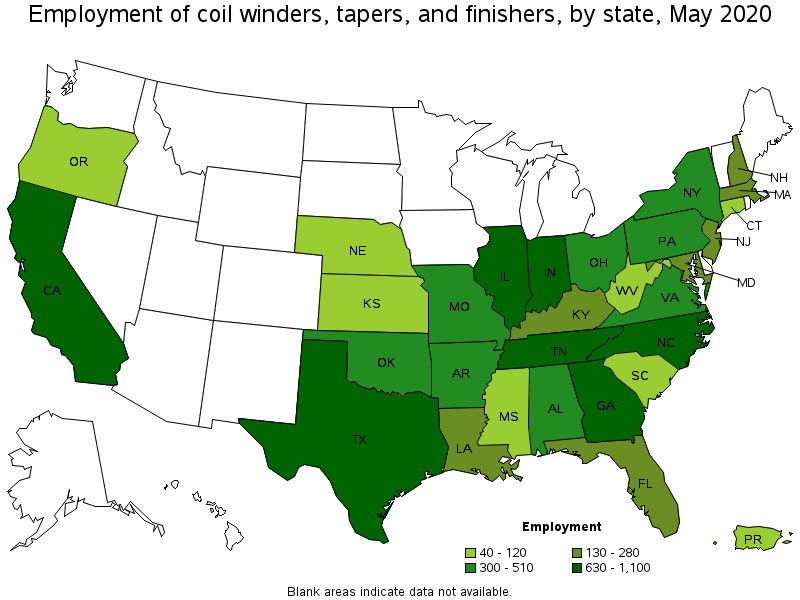
States with the highest employment level in Coil Winders, Tapers, and Finishers:
| State | Employment (1) | Employment per thousand jobs | Location quotient (9) | Hourly mean wage | Annual mean wage (2) |
|---|---|---|---|---|---|
| Illinois | 1,100 | 0.20 | 2.17 | $ 23.56 | $ 49,000 |
| California | 1,050 | 0.06 | 0.71 | $ 19.24 | $ 40,010 |
| Georgia | 980 | 0.23 | 2.52 | $ 19.83 | $ 41,250 |
| North Carolina | 810 | 0.19 | 2.09 | $ 18.84 | $ 39,190 |
| Tennessee | 720 | 0.25 | 2.74 | $ 18.61 | $ 38,710 |
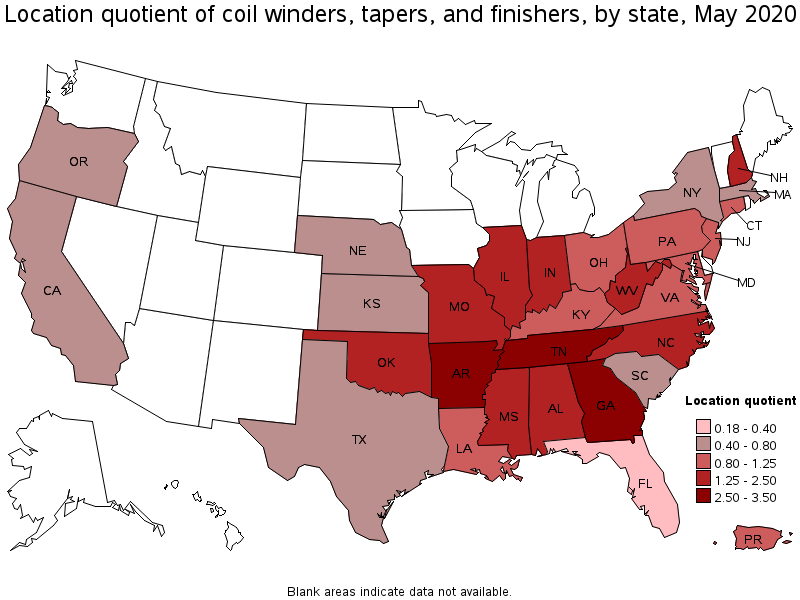
States with the highest concentration of jobs and location quotients in Coil Winders, Tapers, and Finishers:
| State | Employment (1) | Employment per thousand jobs | Location quotient (9) | Hourly mean wage | Annual mean wage (2) |
|---|---|---|---|---|---|
| Arkansas | 330 | 0.28 | 3.07 | $ 20.41 | $ 42,460 |
| Tennessee | 720 | 0.25 | 2.74 | $ 18.61 | $ 38,710 |
| Georgia | 980 | 0.23 | 2.52 | $ 19.83 | $ 41,250 |
| Indiana | 630 | 0.21 | 2.38 | $ 18.73 | $ 38,950 |
| New Hampshire | 130 | 0.21 | 2.28 | $ 17.31 | $ 36,010 |
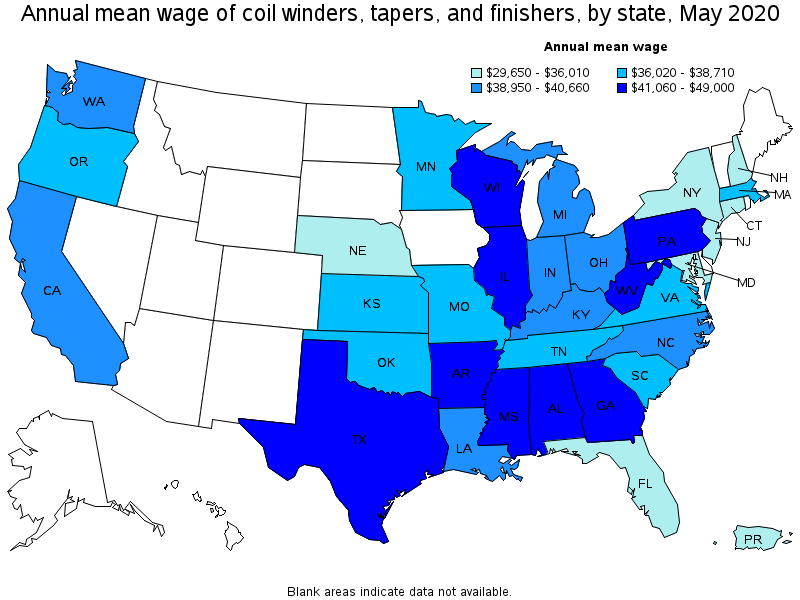
Top paying states for Coil Winders, Tapers, and Finishers:
| State | Employment (1) | Employment per thousand jobs | Location quotient (9) | Hourly mean wage | Annual mean wage (2) |
|---|---|---|---|---|---|
| Illinois | 1,100 | 0.20 | 2.17 | $ 23.56 | $ 49,000 |
| Pennsylvania | 430 | 0.08 | 0.86 | $ 21.96 | $ 45,680 |
| Mississippi | 120 | 0.11 | 1.27 | $ 21.69 | $ 45,110 |
| Alabama | 330 | 0.17 | 1.89 | $ 21.16 | $ 44,020 |
| West Virginia | 90 | 0.14 | 1.56 | $ 20.72 | $ 43,100 |
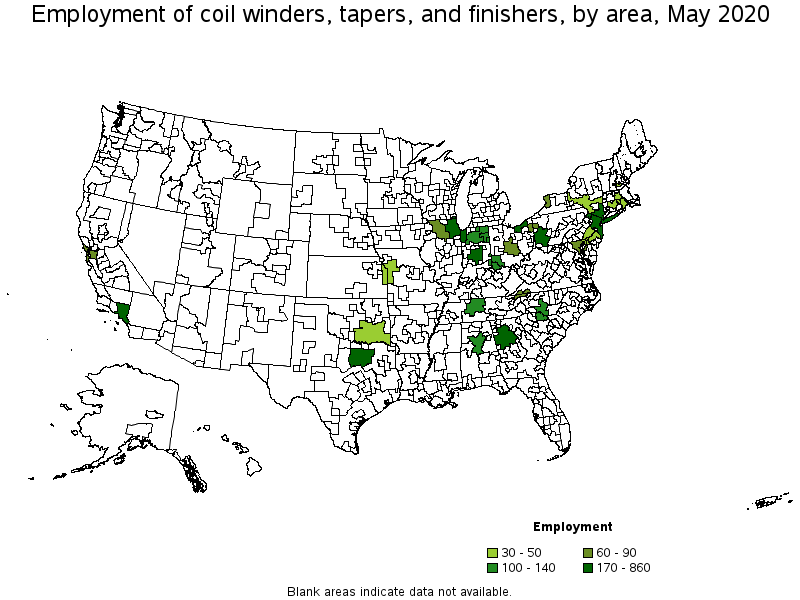
Metropolitan areas with the highest employment level in Coil Winders, Tapers, and Finishers:
| Metropolitan area | Employment (1) | Employment per thousand jobs | Location quotient (9) | Hourly mean wage | Annual mean wage (2) |
|---|---|---|---|---|---|
| Chicago-Naperville-Elgin, IL-IN-WI | 860 | 0.20 | 2.18 | $ 25.41 | $ 52,850 |
| Los Angeles-Long Beach-Anaheim, CA | 680 | 0.12 | 1.30 | $ 19.10 | $ 39,730 |
| Atlanta-Sandy Springs-Roswell, GA | 610 | 0.23 | 2.58 | $ 20.29 | $ 42,200 |
| Pittsburgh, PA | 260 | 0.24 | 2.65 | $ 23.06 | $ 47,960 |
| New York-Newark-Jersey City, NY-NJ-PA | 240 | 0.03 | 0.30 | $ 15.99 | $ 33,260 |
| Cleveland-Elyria, OH | 170 | 0.18 | 1.97 | $ 19.39 | $ 40,340 |
| Indianapolis-Carmel-Anderson, IN | 170 | 0.17 | 1.83 | $ 20.50 | $ 42,650 |
| Dallas-Fort Worth-Arlington, TX | 170 | 0.05 | 0.51 | $ 19.51 | $ 40,590 |
| Charlotte-Concord-Gastonia, NC-SC | 140 | 0.12 | 1.28 | $ 28.32 | $ 58,910 |
| Elkhart-Goshen, IN | 120 | 0.92 | 10.20 | $ 16.87 | $ 35,090 |
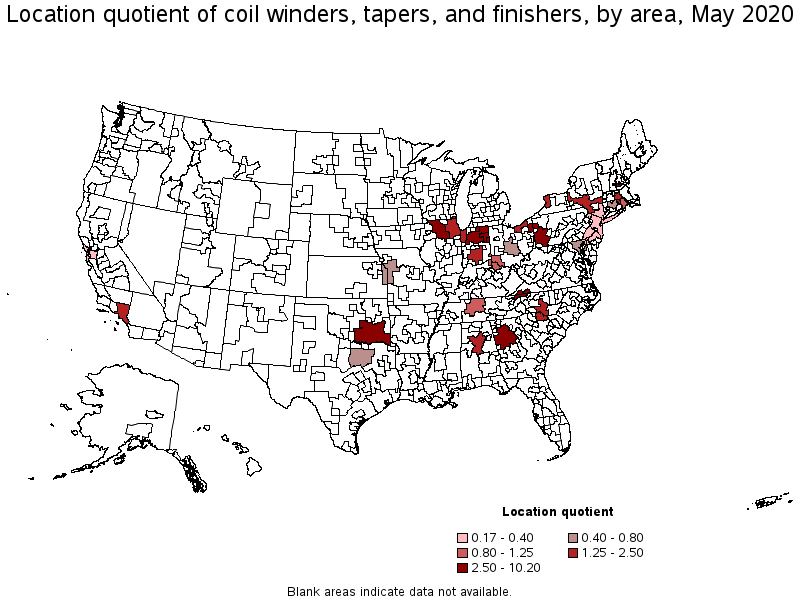
Metropolitan areas with the highest concentration of jobs and location quotients in Coil Winders, Tapers, and Finishers:
| Metropolitan area | Employment (1) | Employment per thousand jobs | Location quotient (9) | Hourly mean wage | Annual mean wage (2) |
|---|---|---|---|---|---|
| Elkhart-Goshen, IN | 120 | 0.92 | 10.20 | $ 16.87 | $ 35,090 |
| Kingsport-Bristol-Bristol, TN-VA | 70 | 0.63 | 6.93 | $ 15.28 | $ 31,780 |
| Fort Wayne, IN | 100 | 0.50 | 5.57 | $ 17.85 | $ 37,130 |
| Manchester, NH | 50 | 0.49 | 5.40 | $ 15.69 | $ 32,620 |
| Youngstown-Warren-Boardman, OH-PA | 70 | 0.35 | 3.89 | $ 19.06 | $ 39,650 |
| Pittsburgh, PA | 260 | 0.24 | 2.65 | $ 23.06 | $ 47,960 |
| Atlanta-Sandy Springs-Roswell, GA | 610 | 0.23 | 2.58 | $ 20.29 | $ 42,200 |
| Chicago-Naperville-Elgin, IL-IN-WI | 860 | 0.20 | 2.18 | $ 25.41 | $ 52,850 |
| Birmingham-Hoover, AL | 100 | 0.19 | 2.12 | $ 21.78 | $ 45,300 |
| Cleveland-Elyria, OH | 170 | 0.18 | 1.97 | $ 19.39 | $ 40,340 |
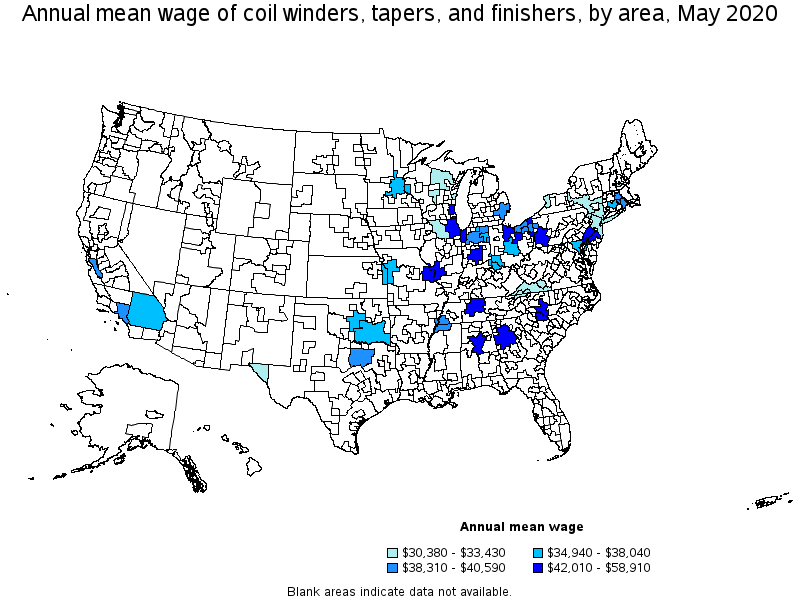
Top paying metropolitan areas for Coil Winders, Tapers, and Finishers:
| Metropolitan area | Employment (1) | Employment per thousand jobs | Location quotient (9) | Hourly mean wage | Annual mean wage (2) |
|---|---|---|---|---|---|
| Charlotte-Concord-Gastonia, NC-SC | 140 | 0.12 | 1.28 | $ 28.32 | $ 58,910 |
| Chicago-Naperville-Elgin, IL-IN-WI | 860 | 0.20 | 2.18 | $ 25.41 | $ 52,850 |
| Pittsburgh, PA | 260 | 0.24 | 2.65 | $ 23.06 | $ 47,960 |
| Philadelphia-Camden-Wilmington, PA-NJ-DE-MD | 40 | 0.02 | 0.17 | $ 22.82 | $ 47,460 |
| Milwaukee-Waukesha-West Allis, WI | (8) | (8) | (8) | $ 22.03 | $ 45,830 |
| Birmingham-Hoover, AL | 100 | 0.19 | 2.12 | $ 21.78 | $ 45,300 |
| Nashville-Davidson--Murfreesboro--Franklin, TN | 110 | 0.11 | 1.20 | $ 21.38 | $ 44,470 |
| Indianapolis-Carmel-Anderson, IN | 170 | 0.17 | 1.83 | $ 20.50 | $ 42,650 |
| Atlanta-Sandy Springs-Roswell, GA | 610 | 0.23 | 2.58 | $ 20.29 | $ 42,200 |
| St. Louis, MO-IL | (8) | (8) | (8) | $ 20.20 | $ 42,010 |
Nonmetropolitan areas with the highest employment in Coil Winders, Tapers, and Finishers:
| Nonmetropolitan area | Employment (1) | Employment per thousand jobs | Location quotient (9) | Hourly mean wage | Annual mean wage (2) |
|---|---|---|---|---|---|
| Northern Indiana nonmetropolitan area | 140 | 0.68 | 7.54 | $ 19.35 | $ 40,250 |
| Northwest Illinois nonmetropolitan area | 70 | 0.56 | 6.17 | $ 14.66 | $ 30,500 |
| Southeast Oklahoma nonmetropolitan area | 50 | 0.31 | 3.47 | $ 17.20 | $ 35,780 |
| Central East New York nonmetropolitan area | 30 | 0.21 | 2.36 | $ 14.61 | $ 30,380 |
Nonmetropolitan areas with the highest concentration of jobs and location quotients in Coil Winders, Tapers, and Finishers:
| Nonmetropolitan area | Employment (1) | Employment per thousand jobs | Location quotient (9) | Hourly mean wage | Annual mean wage (2) |
|---|---|---|---|---|---|
| Northern Indiana nonmetropolitan area | 140 | 0.68 | 7.54 | $ 19.35 | $ 40,250 |
| Northwest Illinois nonmetropolitan area | 70 | 0.56 | 6.17 | $ 14.66 | $ 30,500 |
| Southeast Oklahoma nonmetropolitan area | 50 | 0.31 | 3.47 | $ 17.20 | $ 35,780 |
| Central East New York nonmetropolitan area | 30 | 0.21 | 2.36 | $ 14.61 | $ 30,380 |
Top paying nonmetropolitan areas for Coil Winders, Tapers, and Finishers:
| Nonmetropolitan area | Employment (1) | Employment per thousand jobs | Location quotient (9) | Hourly mean wage | Annual mean wage (2) |
|---|---|---|---|---|---|
| North Northeastern Ohio nonmetropolitan area (noncontiguous) | (8) | (8) | (8) | $ 20.92 | $ 43,510 |
| Northern Indiana nonmetropolitan area | 140 | 0.68 | 7.54 | $ 19.35 | $ 40,250 |
| Southeast Oklahoma nonmetropolitan area | 50 | 0.31 | 3.47 | $ 17.20 | $ 35,780 |
| Southwest Virginia nonmetropolitan area | (8) | (8) | (8) | $ 16.07 | $ 33,430 |
| Northeastern Wisconsin nonmetropolitan area | (8) | (8) | (8) | $ 15.15 | $ 31,520 |
These estimates are calculated with data collected from employers in all industry sectors, all metropolitan and nonmetropolitan areas, and all states and the District of Columbia. The top employment and wage figures are provided above. The complete list is available in the downloadable XLS files.
The percentile wage estimate is the value of a wage below which a certain percent of workers fall. The median wage is the 50th percentile wage estimate—50 percent of workers earn less than the median and 50 percent of workers earn more than the median. More about percentile wages.
(1) Estimates for detailed occupations do not sum to the totals because the totals include occupations not shown separately. Estimates do not include self-employed workers.
(2) Annual wages have been calculated by multiplying the hourly mean wage by a "year-round, full-time" hours figure of 2,080 hours; for those occupations where there is not an hourly wage published, the annual wage has been directly calculated from the reported survey data.
(3) The relative standard error (RSE) is a measure of the reliability of a survey statistic. The smaller the relative standard error, the more precise the estimate.
(8) Estimate not released.
(9) The location quotient is the ratio of the area concentration of occupational employment to the national average concentration. A location quotient greater than one indicates the occupation has a higher share of employment than average, and a location quotient less than one indicates the occupation is less prevalent in the area than average.
Other OEWS estimates and related information:
May 2020 National Occupational Employment and Wage Estimates
May 2020 State Occupational Employment and Wage Estimates
May 2020 Metropolitan and Nonmetropolitan Area Occupational Employment and Wage Estimates
May 2020 National Industry-Specific Occupational Employment and Wage Estimates
Last Modified Date: March 31, 2021